AI Zusammenfassung
Willst du wissen, wie du deine eigene E-Mail-Domain erstellen kannst? Das ist einfacher als du denkst!
In diesem Beitrag zeigen wir dir, wie du eine E-Mail mit deinem Domainnamen erstellen kannst, damit du bei der E-Mail-Kommunikation mit Kunden professioneller, verbindlicher und vertrauenswürdiger wirkst.
Was ist ein E-Mail-Domainname?
Ein E-Mail-Domänenname ist der Teil der E-Mail-Adresse, der nach dem @-Symbol kommt. Zum Beispiel sind gmail.com, outlook.com und yahoo.com alles E-Mail-Domänen.
Die meisten Unternehmen und Freiberufler verwenden einen individuellen Domainnamen, der ihre Marke repräsentiert und zu ihrer offiziellen Website passt. Wenn deine Website zum Beispiel example.com heißt, kannst du eine E-Mail-Adresse in diesem Format erstellen: [email protected].
Es ist gängige Praxis, für professionelle Zwecke eine E-Mail-Adresse mit deinem eigenen Domainnamen zu verwenden. Das hilft bei der Wiedererkennung der Marke und dient als Zeichen der Authentizität, damit deine E-Mail-Empfänger immer wissen, dass du ein offizieller Absender bist, der mit deinem Markennamen verbunden ist (der normalerweise auch der Domainname ist).
Kann ich kostenlos eine eigene E-Mail-Domain erstellen?
Nun, eine benutzerdefinierte E-Mail-Domain bekommst du nicht völlig umsonst. Nur die E-Mail-Domains, die auf den Namen des Mailingdienstes enden, sind kostenlos (Gmail, Outlook, etc.).
Bei einigen Anbietern kannst du jedoch eine benutzerdefinierte E-Mail-Domain als kostenloses Extra zu deinen Webhosting-Plänen erhalten.
Wenn du dein Webhosting auswählst, ist es also sinnvoll, einen Anbieter zu wählen, der kostenlose E-Mails als Bonus anbietet!
Bluehost ist ein solcher Webhosting-Anbieter, der dir eine kostenlose benutzerdefinierte E-Mail-Domain zur Verfügung stellt, sobald du sein Premium-Hosting-Angebot kaufst. Da Bluehost unglaublich günstig ist und dir nur das Webhosting für deine Website in Rechnung stellt, ist der benutzerdefinierte E-Mail-Domainname praktisch kostenlos.
So erstellst du deine eigene E-Mail-Domain
Das Erstellen einer benutzerdefinierten E-Mail-Domain ist eigentlich ganz einfach. Befolge einfach die unten beschriebenen Schritte, um loszulegen.
- Schritt 1: Wähle einen Hosting-Plan und melde dich bei Bluehost an
- Schritt 2: Erstelle deinen kostenlosen Domainnamen
- Schritt 3: E-Mail Adresse unter einer eigenen Domain erstellen
- Schritt 4: Zugriff auf dein benutzerdefiniertes E-Mail-Postfach
Lass uns eintauchen.
Schritt 1: Wähle einen Hosting-Plan und melde dich bei Bluehost an
Wie wir bereits erwähnt haben, sind alle Bluehost-Hosting-Pakete mit kostenlosen benutzerdefinierten E-Mail-Domains ausgestattet. Um zu beginnen, gehe zu Bluehost und klicke auf die Schaltfläche " Jetzt starten".

Auf dem nächsten Bildschirm siehst du Details zu den verfügbaren Bluehost-Tarifen. Bei all diesen Tarifen kannst du kostenlos eine E-Mail-Domain einrichten, aber du solltest auch alle anderen Funktionen berücksichtigen, um die beste Wahl für deine Bedürfnisse zu treffen.
Klicke auf die Schaltfläche Auswählen unter deinem gewünschten Plan, um fortzufahren.
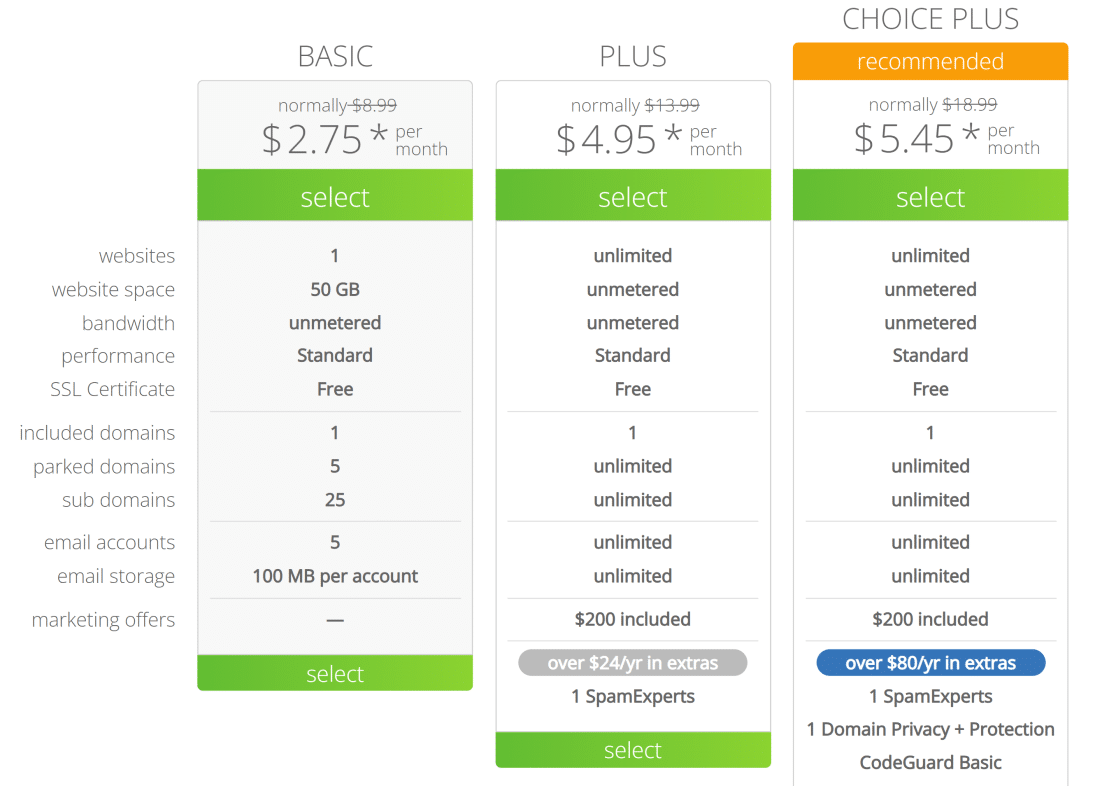
Als Nächstes werden wir deinen neuen Domainnamen erstellen.
Schritt 2: Erstelle deinen kostenlosen Domainnamen
Bluehost wird dich nun auffordern, einen Namen für deine Domain einzugeben. Dieser Domainname wird der Name deiner Website und auch deine E-Mail-Domain sein.
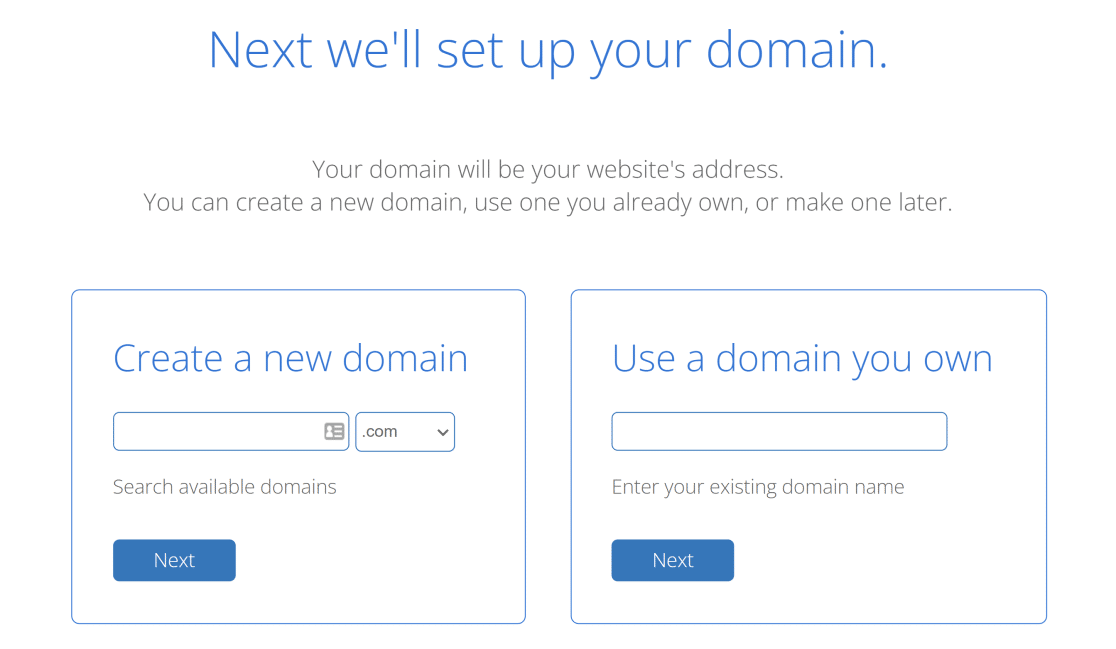
Wenn du noch nicht über den Namen deines Unternehmens nachgedacht hast, wäre jetzt ein guter Zeitpunkt. Normalerweise passt der Name der Website und der E-Mail-Domain gut zu deinem Unternehmensnamen. Eine einfache Möglichkeit, Inspirationen für einen Geschäftsnamen zu bekommen, ist dieses kostenlose Tool zum Generieren von Geschäftsnamen.
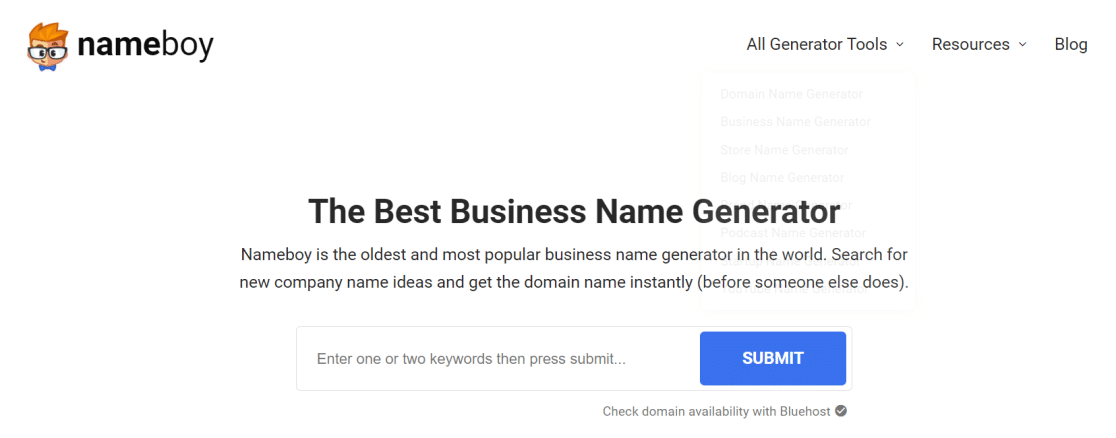
Wenn du dich für deinen Unternehmensnamen entschieden und seine Verfügbarkeit mit dem oben genannten Tool von Nameboy überprüft hast, gibst du diesen Domainnamen in die Maske zur Erstellung einer neuen Domain bei Bluehost ein.
Bluehost wird dich nun nach deinen Rechnungsdaten fragen, um die Einrichtung deiner Domain abzuschließen. Du erhältst eine Willkommens-E-Mail von Bluehost, sobald du dein Hosting-Konto eingerichtet hast.
Jetzt, wo der Domainname eingerichtet ist, können wir eine neue E-Mail-Adresse mit deinem Unternehmensnamen als E-Mail-Domain erstellen.
Schritt 3: E-Mail-Adresse unter einer eigenen Domain erstellen
Um eine E-Mail-Adresse für deine neue benutzerdefinierte Domain zu erstellen, logge dich zunächst in dein Bluehost-Konto ein.
Klicke jetzt auf den Menüpunkt E-Mail & Office auf der linken Seite und dann auf die Schaltfläche Verwalten neben deinem Domainnamen.

So kommst du zu deinem E-Mail-Konto. Klicke auf die Schaltfläche Erstellen, um fortzufahren.
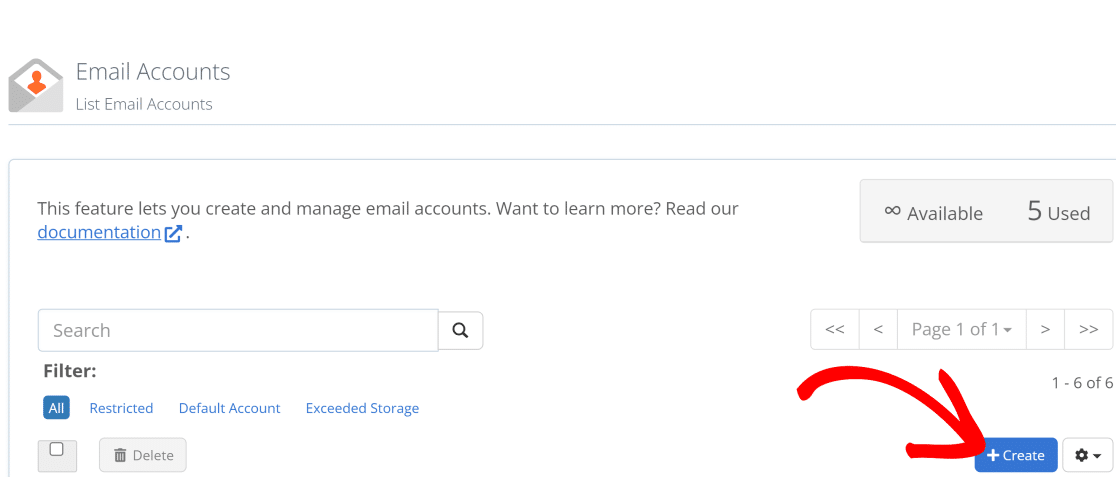
Hier kannst du einen beliebigen Benutzernamen für deine E-Mail auswählen. Dein Benutzername ist der Teil der E-Mail-Adresse, der vor dem @-Symbol steht. Der Teil nach dem @-Symbol ist bereits auf deinen eigenen Domänennamen eingestellt.
Du fragst dich vielleicht, ob bei E-Mail-Adressen zwischen Groß- und Kleinschreibung unterschieden wird? Die schnelle Antwort lautet: Nein. Es ist jedoch üblich, dass E-Mail-Adressen in Kleinbuchstaben formatiert werden. Wenn du in deiner E-Mail eine Mischung aus Groß- und Kleinbuchstaben verwendest, kann es sein, dass sie standardmäßig klein geschrieben wird.
Du brauchst auch ein sicheres Passwort für deine E-Mail-Adresse. Klicke einfach auf die Schaltfläche " Erzeugen" neben dem Passwortfeld, damit Bluehost automatisch ein sicheres Passwort für dich erstellen kann.
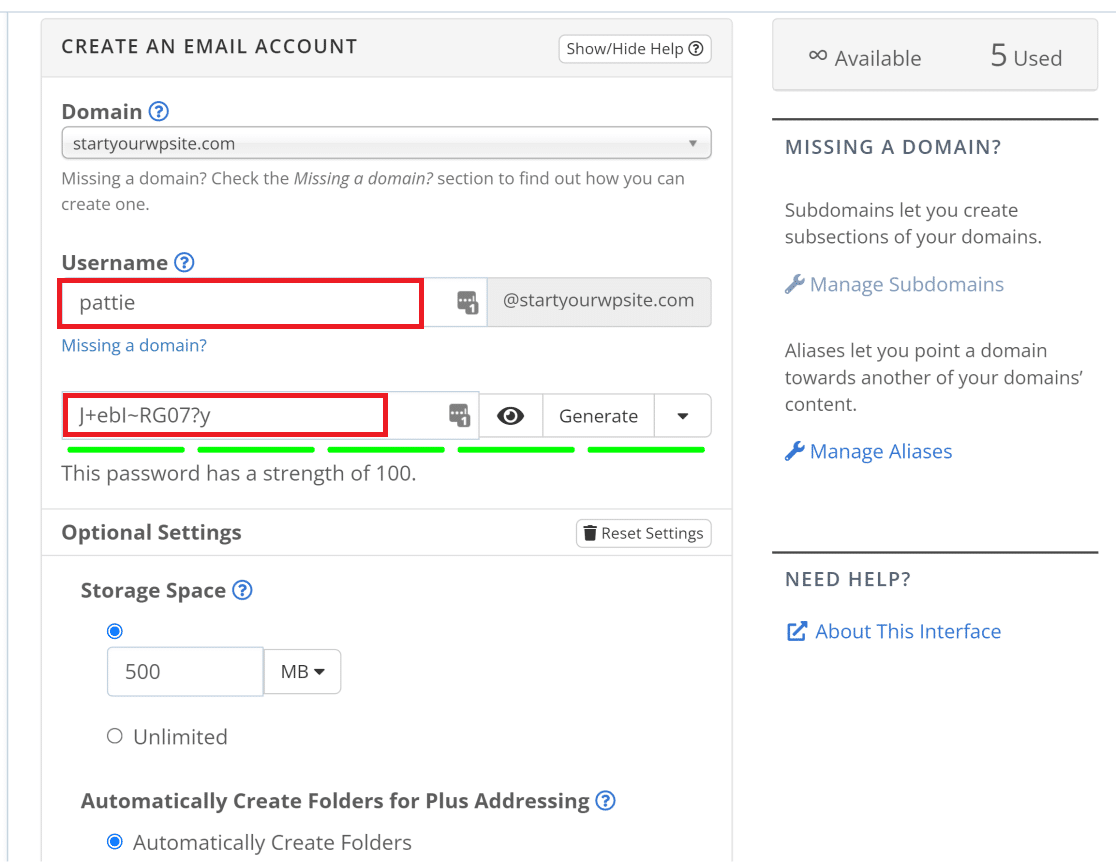
Du kannst auch deinen E-Mail-Speicherplatz festlegen und andere Einstellungen im Abschnitt Optionale Einstellungen ändern. Beachte, dass der Basic-Tarif von Bluehost nur einen maximalen Speicherplatz von 100 MB bietet. Wenn du also unbegrenzten Speicherplatz möchtest, empfehlen wir dir, Bluehost Plus oder höher zu wählen.
Wenn du fertig bist, scrolle nach unten und klicke auf Erstellen.
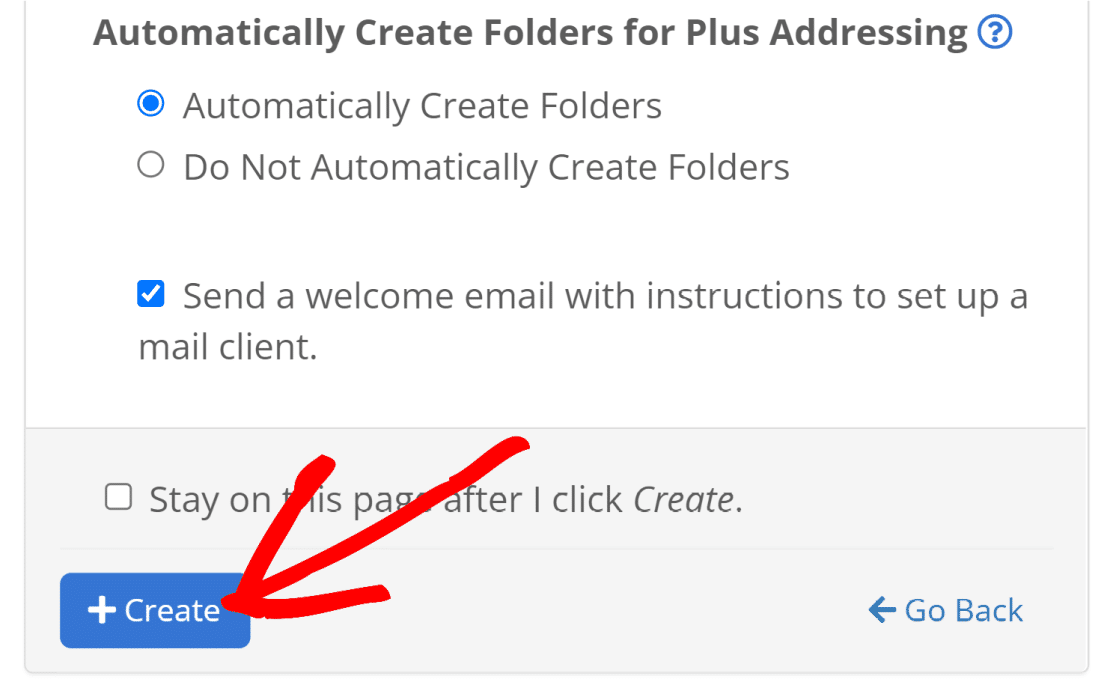
Dadurch wird dein E-Mail-Konto unter deinem eigenen Domainnamen erstellt. Jetzt kannst du auf dein Postfach zugreifen, um Nachrichten über deine neue geschäftliche E-Mail-Adresse zu senden und zu empfangen.
Schritt 4: Zugriff auf dein benutzerdefiniertes E-Mail-Postfach
Bluehost bringt dich zurück zu deiner E-Mail-Kontoseite, nachdem deine neue E-Mail-Adresse erstellt wurde.
Klicke auf die Schaltfläche E-Mail prüfen.

Klicke dann einfach auf Öffnen, um auf das Postfach deiner neuen benutzerdefinierten E-Mail-Domain zuzugreifen.
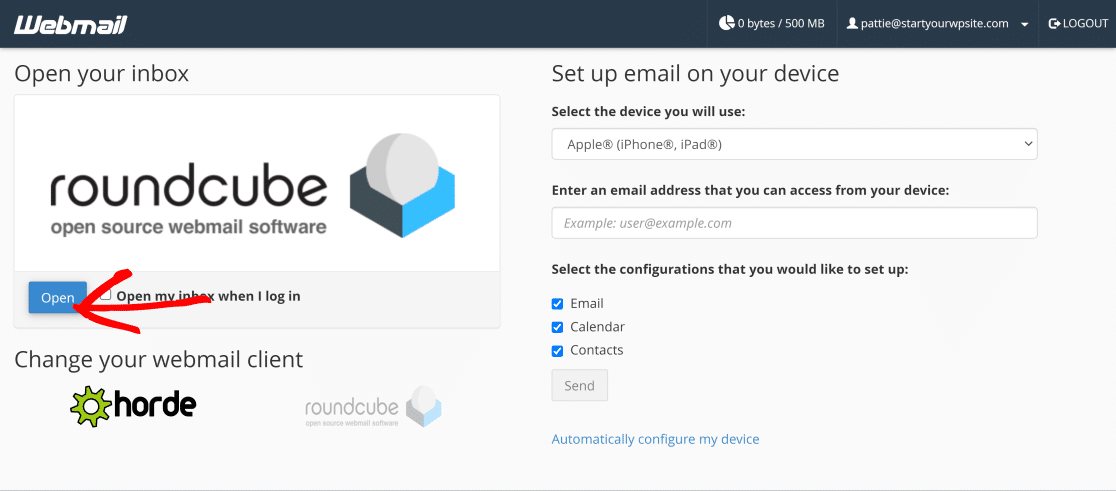
So sieht unsere neue E-Mail-Adresse unter einer benutzerdefinierten Domain aus:
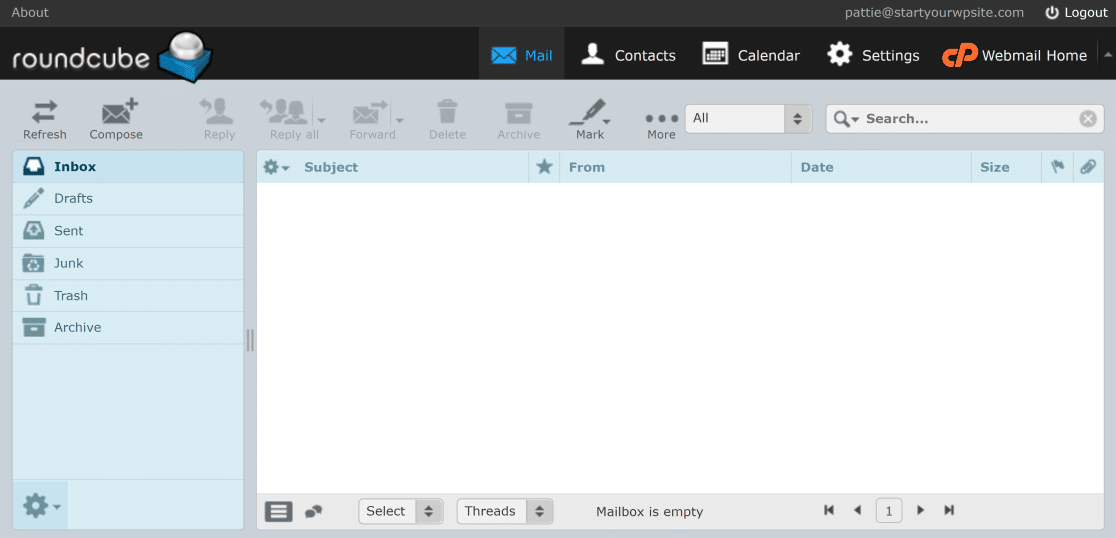
Du kannst die E-Mail-Adresse, die du gerade erstellt hast, auch mit Desktop-Mailprogrammen wie Microsoft Outlook verbinden. Dazu musst du bei der Outlook-Konfiguration nur deine E-Mail-Adresse und dein Passwort eingeben (das du bei der Erstellung der neuen E-Mail-Adresse verwendet hast).
Du solltest dann in der Lage sein, von Outlook aus auf dein neues benutzerdefiniertes E-Mail-Konto zuzugreifen.
Und das war's! Du weißt jetzt, wie du mit einem Bluehost-Hosting-Account kostenlos deine eigene E-Mail-Domain einrichten kannst.
FAQ - So erstellst du kostenlos deine eigene E-Mail-Domain
Hier findest du einige der am häufigsten gestellten Fragen, die wir zur Erstellung deiner eigenen freien Domain erhalten.
Wie richte ich eine kostenlose E-Mail-Domain ein?
Um eine kostenlose E-Mail-Domain einzurichten, musst du als Erstes einen freien Domainnamen finden und sichern. Dann registrierst du diesen Domainnamen in deinem Konto und konfigurierst deine DNS-Einträge so, dass sie auf deinen E-Mail-Host zeigen. Zum Schluss aktualisierst du die Einstellungen deines E-Mail-Anbieters.
Wie kann ich die Domain auf meinen E-Mail-Dienst verweisen?
Ändere in der DNS-Konfiguration deiner Domain den Mail Exchange Record (oder MX-Record) so, dass er mit den Informationen übereinstimmt, die dein E-Mail-Dienst bereitstellt.
Wie lange dauert es, bis sich eine neue Domain verbreitet?
Du kannst davon ausgehen, dass sich deine neuen Nameserver innerhalb von 24-48 Stunden über die DNS-Server verbreiten.
Wird meine E-Mail-Domain jemals auslaufen?
Ja, deine E-Mail-Domain wird auslaufen. Dies geschieht in der Regel in regelmäßigen Abständen, in der Regel einmal im Jahr. In der Regel erhältst du vor dem Ablauf mehrere Erinnerungen, damit du sie verlängern kannst, wenn du möchtest.
Führt eine kostenlose E-Mail-Domain dazu, dass meine E-Mails im Spam landen?
Es gibt bestimmte kostenlose E-Mail-Domains, die relativ weit verbreitet sind, wie .email, .info und sogar .net. In der Regel kannst du diese kostenlosen Domains ziemlich sicher nutzen. Es gibt aber auch andere, die nicht so verbreitet sind. Deshalb besteht ein höheres Risiko, dass deine E-Mails als Spam verschickt werden.
Als nächstes erstellst du eine E-Mail-Subdomain
Jetzt, wo du eine eigene Domain und eine eigene E-Mail-Adresse hast, solltest du auch eine E-Mail-Subdomain ein richten. Eine E-Mail-Subdomain hilft dir, die E-Mail-Reputation deiner Root-Domain aufrechtzuerhalten und Probleme zu vermeiden, wie z. B. dass WordPress-E-Mails im Spam landen oder dass du keine E-Mail-Benachrichtigungen von WooCommerce erhältst.
Weitere Informationen über die Ursachen von E-Mail-Problemen findest du in unserem ausführlichen Artikel über die Zustellbarkeit von E-Mails.
Repariere deine WordPress-E-Mails jetzt
Bist du bereit, deine E-Mails zu verbessern? Starten Sie noch heute mit dem besten WordPress SMTP-Plugin. WP Mail SMTP Elite beinhaltet ein vollständiges White Glove Setup und bietet eine 14-tägige Geld-zurück-Garantie.
Wenn dir dieser Artikel geholfen hat, dann folge uns bitte auf Facebook und Twitter für weitere WordPress-Tipps und -Anleitungen.

